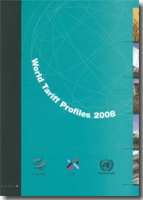
The World Tariff Profi les 2009 is the latest edition issue of this inter-agency statistical publication devoted tomarket access. The reader will fi nd in this comprehensive report the main tariff parameters for each of the 153WTO Members and also a few other countries and customs territories. The description of the tariffs imposedby each economy on its imports is complemented with an analysis of the market access conditions it faces inits major export markets. The present publication provides a comprehensive picture of tariff and ad valoremequivalents in an abridged format.
This joint publication of the WTO, UNCTAD and the ITC responds to the needs of a large audience ofspecialists and non-specialists alike. Tariff duties play a fundamental role in key areas of trade negotiations.Perhaps more than in any previous multilateral round of trade negotiations, tariff reduction modalities have beenat the core of the Doha negotiations.
The standardized presentation lends itself to easy analyses and comparisons between countries, betweensectors and between bound and applied duties for WTO Members. This ease of use should not mask, however,that a number of caveats apply when information is highly aggregated and when estimates are used for calculatingad valorem equivalents (AVEs) of non-ad valorem duties. The reader is advised to read the methodological notesthat precede the statistical tables. The standard Harmonized System (HS) nomenclature breakdown was chosenas yardstick for most calculations lest the very diverse breakdowns of national tariff line nomenclatures affect thecomparability between bound and applied duties and across countries.
The publication is presented in three main parts. The fi rst part shows summary statistics for all countries andterritories for all products, as well as a break-down into agricultural and non-agricultural products. The secondpart shows for each of these countries and territories, one full page with disaggregation by sectors and dutyranges. It also contains a section on the market access conditions faced in their respective major export markets.The third part contains a summary table on concessions on Other Duties and Charges (ODCs).
The summary tables in the fi rst part are designed to allow a cross-country comparison as well as a comparisonof the levels of bound and applied duties. Apart from the standard indicators like tariff averages, maxima,percentage of duty-free tariff lines, peaks and non-ad valorem duties, it also contains indicators of tariff dispersionsuch as the number of distinct duties and the coeffi cient of variation. The calculation of these indicators is based,where applicable, on a pre-aggregation to HS six-digit subheadings, which leads to a standardization acrosscountries and thus makes the comparisons more compatible.
The country pages are divided into two blocks covering (A) the domestic market access protection and (B)the protection faced in the major export markets. In part A, information on bound and applied duties is shownby duty ranges and by sectors. Information for agricultural and non-agricultural duties is shown separately. Inaddition, there are indicators on the occurrence of special safeguards and on tariff quotas. In part B, the tradediversifi cation and market access conditions in the fi ve major export markets are depicted, broken down intoagricultural and non-agricultural products.
The third part contains the technical annex which for this issue is the reprint of the summary statistics onconcessions on ODCs. The data sources and a glossary, which briefl y explains some of the most commonly usedtariff and trade-related terms, conclude the publication.



